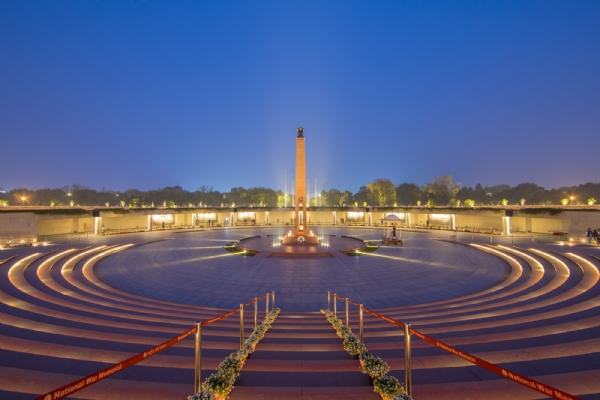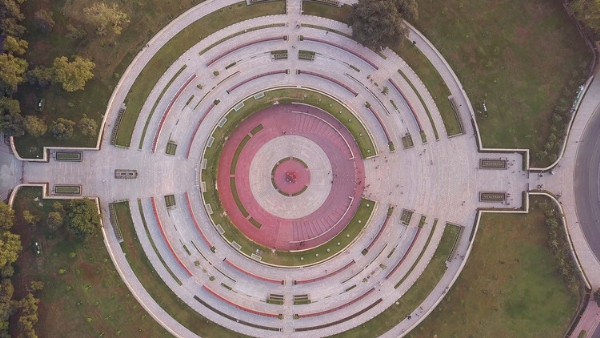Rashtriya Samar Smarak: A pilgrimage for Indians to salute the supreme sacrifice made by Armed Forces
The National War Memorial has been a long-cherished dream of not only the men and women in uniform and the brave families of our gallant soldiers but also of the nation. This iconic memorial would serve to immortalize the supreme sacrifice made by the men and women of the Indian Armed Forces.
Total Views | 229
They are not merely soldiers to India, they are the pride of every Indian soul! Away from their families, guarding the nation across extreme weather and critical ground conditions, 'they' have the guts to sacrifice lives for the sake of countrymen, willingly! These were the exact thoughts striking our minds as I entered the National War Memorial in Delhi.
The need to construct National War Memorial?
The iconic India Gate in Lutyen's Delhi was constructed in 1931 by erstwhile British empire to commemorate the Martyrs of India during World War I as well as Third Anglo-Afghan War. It stands tall as a must visit monument for visitors in New Delhi. Out of over 83,000 Indians who laid down their lives, India Gate bears just 13,516 names, etched all over the monument.

Apart from that, our Indian Armed Forces has been involved in many conflicts of different magnitudes and participated in innumerable operations both inland and overseas. Our country continues to engage in counter-terrorism operations and proxy war from across the front resulting in number of battle casualties. While a number of area/battle specific memorials are built across the country, but no memorial existed that was all - encompassing.
Since-Independence, more than 26,000 soldiers of the Indian Armed Forces have made the supreme sacrifice to defend the sovereignty and integrity of the country. The National War Memorial thus represents the gratitude of a nation to its Armed Forces. The Memorial will help strengthen the sense of belonging, high moral values, sacrifice and national pride in our citizens. It shall stand testimony to the sacrifices made by our soldiers during various conflicts, United Nations Operations, Humanitarian Assistance and Disaster Response Operations since Independence.
The Structure
The Memorial has four concentric circles and a central obelisk, at the bottom of which burns an 'eternal flame' representing the immortal soldier, 'Amar jawan'. The four circles are, Amar Chakra (circle of immortality), Veer Chakra (circle of bravery), Tyag Chakra (circle of sacrifice) and Rakshak Chakra (circle of protection) will include a 15-metre tall central obelisk with the eternal flame, bronze murals, graphic panels, the inscription of names of martyrs and busts of the 21 Param Vir Chakra.

After it was proposed six decades ago by the Indian Armed Forces, the National War Memorial was finally built in 2019 and was inaugurated by PM Narendra Modi, sprawled over 40 acres at the India Gate complex in Delhi. However, to pinpoint, it's important to think about what exactly took so long, almost six decades, to build NWM? Why does politico-bureaucratic apathy play a part in constructing the NWM, that honors more than 25,000 soldiers who have laid their lives down since Independence?
Why Modi Hai Toh Mumkin Hai?
India is probably the only major country that did not have a war memorial. Everything cannot be politicized, come on! Back in 2012, former Delhi CM Sheila Dixit had turned a bit blatant, opposing the NWM plan. She had said that it would affect the ambiance of that area and restrict people’s movement at one of the popular hangout zones, the India Gate. Nevertheless, this plan got successful when the Modi-led government passed a proposal in 2015 sanctioning Rs 500 crores for the NWM.

Prime Minister Narendra Modi on February 25, 2019, inaugurated the NWM, where names of 25,942 soldiers have been inscribed in golden letters on granite tablets.
Amar Jawan Jyoti merged with eternal flame at National War Memorial
In a historical move by the Centre ahead of the Republic Day celebrations, the Amar Jawan Jyoti, or the "eternal flame" for soldiers at India Gate was merged with the torch at the National War Memorial in a ceremony. A part of the flame was carried to the war memorial this afternoon in a ceremony that was presided by the Integrated Defence Staff chief Air Marshal Balabadhra Radha Krishna. He laid a wreath after which a torch was lit from the Amar Jawan Jyoti and the flame doused.
India Gate is itself a memorial to more than 70,000 Indian soldiers of the British Indian Army who died in between 1914–1921 in the 1st World War and the 3rd Anglo-Afghan War. With the Amar Jawan Jyoti later being built under its arch to honor soldiers who died liberating Bangladesh in 1971, why do we have to wait for so many years to pay homage to our military men? This easy highlights one of those 'Chanakya lines'. The day the soldier has to demand his dues, will be a sad day!
Now, India holds up to respect, remember the courage and valor of 'our men' at the National War Memorial. But are we all striving enough to maintain the dignity, decorum, and grace of this sacred place? Do we really carry the significance of that central obelisk, that it actually holds? Aren't we supposed to connect evidence to that sanctified monument, deep down the sea and that above the mountains? Let's pledge at first to understand and accept its realism and then cater to its divinity!
Bharati Web








